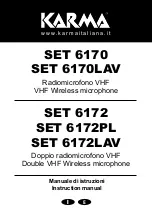
. . . . . . . . . . . . . . . . . . . . . . . . . . . . . . . . . . . . . . . . . . . . . . . . . . . . . . . . . . . . . . . . . . . . . . . . . . . . . . . . . . . . . . . . . .
Polar-Pattern Selection
Bidirectional
Bidirectional mode captures sound directly in front of and directly behind the microphone
while it rejects sound from the sides. The bidirectional polar pattern is a time- and
space-saver because you can record two subjects with a single microphone.
Bidirectional polar pattern is best for recording interviews, conversations, or vocal duets.
It will deliver a natural sound that would ordinarily require two microphones.
Omnidirectional
In omnidirectional mode, the microphone picks up sound in a 360° pattern. Sounds
are equally clear and loud no matter with direction they come from. Omnidirectional
polar pattern also picks up the most ambiance and room noise, so the omnidirectional
setting is usually most effective in rooms with adequate acoustic treatment.
The omnidirectional polar pattern is best when recording a large meeting or
conversation, band rehearsal, or multiple people sitting around a conference table.
12






































